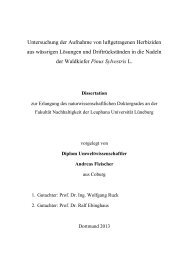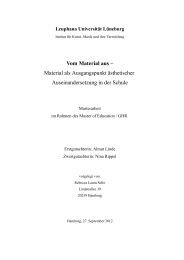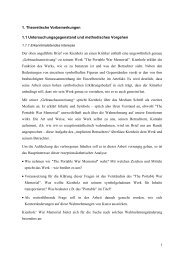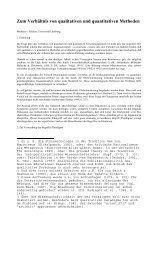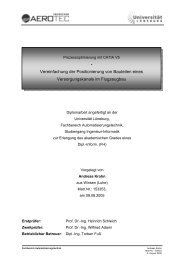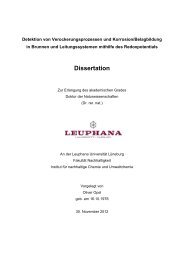Determinants of Emotional Experiences in Traffic Situations ... - OPUS
Determinants of Emotional Experiences in Traffic Situations ... - OPUS
Determinants of Emotional Experiences in Traffic Situations ... - OPUS
Create successful ePaper yourself
Turn your PDF publications into a flip-book with our unique Google optimized e-Paper software.
Introduc<strong>in</strong>g a Multivariate Model for Predict<strong>in</strong>g Driv<strong>in</strong>g Performance 111<br />
anger (Philippe et al., 2009) as well as gender, age and mileage with at least some aspects <strong>of</strong> driv<strong>in</strong>g<br />
related anger (Björklund, 2008, Lajunen & Parker, 2001). This was not the case here, which can be<br />
expla<strong>in</strong>ed by the change <strong>in</strong> the object <strong>in</strong>cit<strong>in</strong>g the anger. In this study, we used film material that was<br />
not related to the traffic situation. After see<strong>in</strong>g the film and engag<strong>in</strong>g <strong>in</strong> a driv<strong>in</strong>g task, anger levels<br />
weren’t related to the new context anymore. Driv<strong>in</strong>g motivation and trait driv<strong>in</strong>g anger predict context<br />
specific anger, which has its cause <strong>in</strong> traffic situations but seems to fail to expla<strong>in</strong> other sources <strong>of</strong><br />
anger. This raises the question <strong>of</strong> whether the emotional object and its change dur<strong>in</strong>g the experiment<br />
(from film to driv<strong>in</strong>g task) as well as the assessment <strong>of</strong> the anger emotion <strong>in</strong> the driv<strong>in</strong>g simulator was<br />
adequate for our cause.<br />
Therefore a second study was set up with the primary goal to reproduce the results <strong>of</strong> the first<br />
explorative study. Furthermore, the focus <strong>of</strong> the emotional object was shifted from an external movie<br />
to the traffic situation itself, which could ensure the relationship between anger and driv<strong>in</strong>g behaviour<br />
patterns. The driv<strong>in</strong>g segments were standardized <strong>in</strong> order to make the track segments more<br />
homogenous, reduce variances <strong>in</strong> driv<strong>in</strong>g patterns and enhance the precision <strong>of</strong> measurement.<br />
4.3 Study 2<br />
!<br />
4.3.1 Method<br />
4.3.1.1 Participants<br />
N = 80 drivers (60% female) took part <strong>in</strong> this study. The participants’ ages ranged from 18 years to 52<br />
years (M = 24.47; SD = 5.99), with an average driv<strong>in</strong>g experience <strong>of</strong> M = 6.49 years (SD = 5.66).<br />
They drove on average 7,870 kilometres per year (SD = 9,240) and had a total mileage <strong>of</strong> 73,980<br />
kilometres (SD = 112,600). Participants were mostly recruited on the university campus. They were<br />
compensated for their participation with a small present worth 15 Euro.<br />
4.3.1.2 Stimulus Material<br />
The simulated track was a 17,120 m rural route where four critical events took place. The first<br />
situation was a construction site block<strong>in</strong>g the progress <strong>of</strong> the participant for two m<strong>in</strong>utes and therefore<br />
a significant amount <strong>of</strong> time. There was no possibility to pass the construction site earlier due to<br />
steady oncom<strong>in</strong>g traffic. The second situation was a car driv<strong>in</strong>g very slowly <strong>in</strong> front <strong>of</strong> the participant.<br />
Aga<strong>in</strong>, pass<strong>in</strong>g the car was not possible until the road broadened, which forced the participant to stay<br />
beh<strong>in</strong>d the car for approximately two m<strong>in</strong>utes. The third situation consisted <strong>of</strong> a car <strong>in</strong> front, brak<strong>in</strong>g<br />
suddenly and forc<strong>in</strong>g the participant to react quickly. The fourth situation was a barely secured hole <strong>in</strong><br />
the street <strong>in</strong> a curve and the participant had to evade <strong>in</strong> order not to crash. After each scenario, a<br />
standardized section 2,200 m <strong>in</strong> length and with various curves served as the foundation for driv<strong>in</strong>g<br />
!



